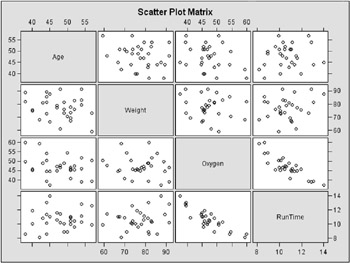Getting Started
The following statements create the data set Fitness , which has been altered to contain some missing values:
*----------------- Data on Physical Fitness -----------------* These measurements were made on men involved in a physical fitness course at N.C. State University. The variables are Age (years), Weight (kg), Runtime (time to run 1.5 miles in minutes), and Oxygen (oxygen intake, ml per kg body weight per minute) Certain values were changed to missing for the analysis. *------------------------------------------------------------*; data Fitness; input Age Weight Oxygen RunTime @@; datalines; 44 89.47 44.609 11.37 40 75.07 45.313 10.07 44 85.84 54.297 8.65 42 68.15 59.571 8.17 38 89.02 49.874 . 47 77.45 44.811 11.63 40 75.98 45.681 11.95 43 81.19 49.091 10.85 44 81.42 39.442 13.08 38 81.87 60.055 8.63 44 73.03 50.541 10.13 45 87.66 37.388 14.03 45 66.45 44.754 11.12 47 79.15 47.273 10.60 54 83.12 51.855 10.33 49 81.42 49.156 8.95 51 69.63 40.836 10.95 51 77.91 46.672 10.00 48 91.63 46.774 10.25 49 73.37 . 10.08 57 73.37 39.407 12.63 54 79.38 46.080 11.17 52 76.32 45.441 9.63 50 70.87 54.625 8.92 51 67.25 45.118 11.08 54 91.63 39.203 12.88 51 73.71 45.790 10.47 57 59.08 50.545 9.93 49 76.32 . . 48 61.24 47.920 11.50 52 82.78 47.467 10.50 ;
The following statements invoke the CORR procedure and request a correlation analysis:
ods html; ods graphics on; proc corr data=Fitness plots; run; ods graphics off; ods html close;
This graphical display is requested by specifying the experimental ODS GRAPHICS statement and the experimental PLOTS option. For general information about ODS graphics, refer to Chapter 15, Statistical Graphics Using ODS ( SAS/STAT User s Guide ). For specific information about the graphics available in the CORR procedure, see the section ODS Graphics on page 31.
| |
The CORR Procedure 4 Variables: Age Weight Oxygen RunTime Simple Statistics Variable N Mean Std Dev Sum Minimum Maximum Age 31 47.67742 5.21144 1478 38.00000 57.00000 Weight 31 77.44452 8.32857 2401 59.08000 91.63000 Oxygen 29 47.22721 5.47718 1370 37.38800 60.05500 RunTime 29 10.67414 1.39194 309.55000 8.17000 14.03000
| |
Figure 1.1: Univariate Statistics
By default, all numeric variables not listed in other statements are used in the analysis. Observations with nonmissing values for each variable are used to derive the univariate statistics for that variable.
By default, Pearson correlation statistics are computed from observations with nonmissing values for each pair of analysis variables. With missing values in the analysis, the Pearson Correlation Coefficients table shown in Figure 1.2 displays the correlation, the p -value under the null hypothesis of zero correlation, and the number of nonmissing observations for each pair of variables.
| |
Pearson Correlation Coefficients Prob > r under H0: Rho=0 Number of Observations Age Weight Oxygen RunTime Age 1.00000 -0.23354 -0.31474 0.14478 0.2061 0.0963 0.4536 31 31 29 29 Weight -0.23354 1.00000 -0.15358 0.20072 0.2061 0.4264 0.2965 31 31 29 29 Oxygen -0.31474 -0.15358 1.00000 -0.86843 0.0963 0.4264 <.0001 29 29 29 28 RunTime 0.14478 0.20072 -0.86843 1.00000 0.4536 0.2965 <.0001 29 29 28 29
| |
Figure 1.2: Pearson Correlation Coefficients
The table displays a correlation of ˆ’ 0.86843 between Runtime and Oxygen , which is significant with a p -value less than 0.0001. That is, there exists an inverse linear relationship between these two variables. As Runtime (time to run 1.5 miles in minutes) increases , Oxygen (oxygen intake, ml per kg body weight per minute) decreases.
The experimental PLOTS option displays a symmetric matrix plot for the analysis variables. This inverse linear relationship between these two variables, Oxygen and Runtime , is also shown in Figure 1.3.

Figure 1.3: Symmetric Matrix Plot (Experimental)
EAN: 2147483647
Pages: 74